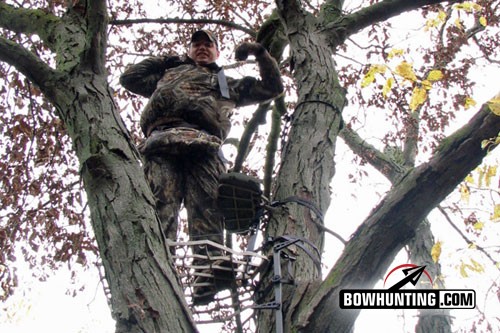LAST UPDATED: May 8th, 2015
Months of preparation, hours and hours of practice time, days of hanging stand after stand, all come down to one split second, one opportunity to loose an arrow at the whitetail of your dreams, or at least, the whitetail of the moment. When the shot finally happens there is a great sense of relief; especially if it is a solid hit. However, before you start reaching for that tag there are a few steps that should be taken to ensure you make the right decisions during this very critical, but often overlooked, time.
Unless you witness your deer “topple-over”, don’t assume that you’ve made a lethal hit. Follow up with caution until your hands are wrapped around the antlers for real.
Remember the last Spot
If the deer you’ve just shot happens to run away, pay special attention to the very last place it was standing (or running) before loosing sight of it. Look for easily recognizable landmarks such as rocks, downed trees or unique logs. These will aid you in locating that “last spot seen” once you are actually on the ground because the topography will look vastly different once you climb out of your stand. This can result in following the wrong trail and possibly loosing your deer.
There is a huge difference in how things look from 20 feet up in a treestand and ground level. This can add confusion to an already tedious moment in the hunt.
In addition, once the animal is no longer visible, you should pay special attention to any noise or racket in order to determine if your animal has crashed to the ground or has kept running. Even fatally shot deer will run. Some make it a short distance and fall dead, some run a little further before expiring. Either way, there is no set distance to how far they can or will run; even if your arrow passes completely through the boiler room.
Once your deer is out of sight, your sense of hearing should take over in order to detect the sound of cracking limbs or the overabundance of leaves rustling….followed by dead silence.
Find your Arrow
The reason it’s so vital to find your arrow is simple. It holds a ton of clues as to the location of impact. For instance, an arrow covered in bright red blood, filled with tiny air bubbles, indicates a solid lung hit. An arrow with brown and green residue on it, accompanied by a “staunch” odor is typical of a gut shot animal. And lastly, dark red blood on your arrow may be an indication of a liver hit.
You never really know what your arrow is going to do after it impacts flesh and bone. Therefore, it is vital to locate it if at all possible in order to better evaluate the situation.
If you typically experience trouble locating your arrow after the shot, there are several aftermarket items designed to help bowhunters not only find their arrow after the shot, but watch it while it is in flight as well. One such product is “lighted” nocks. Much like a tracer round fired from a rifle, arrows with lighted nocks are highly visible from the moment they leave the bowstring until the instant they disappear into hide and hair. This makes determining exactly where your arrow impacted much easier; which in turn will help you make the best decisions about how badly the animal is hurt and when to take up the trail.
Lighted nocks greatly enhance your ability to “track” your arrow in flight. Arrow “wraps” are also a good idea if you have trouble finding your arrow once it is on the ground.
Tic Toc, Tic Toc
You’ve found your arrow. You’ve determine to the best of your ability what type of hit it was. Now you must decide what to do. For starters, even if I know my shot was on the money, I think it is a wise choice not to follow the blood trail for at least 20-30 minutes. That may sound like a long time; especially if you know your buck is lying just around the point. However, when you consider the time it takes to gather your composure, collect your gear, and climb down, such a waiting period will go by rather quickly.
Climbing down too soon after the shoot can not only hurt your chances of recovering your deer, it can also increase the odds that you injure yourself. Maneuvering down a tree while under the influence of adrenaline isn’t the smartest thing to do. Settle your nerves first, then climb down.
When it comes to recovering your deer, the “gut shot” doesn’t have to be the kiss of death. The problem arises from bowhunters pushing deer too soon. A gut shot deer is likely going to die. The trick is to leave it alone and let it expire as closely to where you shot it as possible. Since there will be very little blood to follow, it is vital that the deer drop within close proximity of your stand site. Otherwise, a long tracking job usually results in a lost deer.
Gut shot deer get a minimum of 8 hours wait time in my book. If I happen to make this shot right before last light, I will usually elect to return the next morning; making sure I leave the area as quietly as possible. If it is the start of a hot, early season day, I will usually cut that time in half; hoping to recover the deer before meat spoilage occurs; making a bad situation even worse.
This buck was left to lay overnight after a suspected liver shot. Expecting to find the deer piled-up the next morning, the author and his hunting buddy were astonished when the bruiser sprang to his feet mere yards from them. A follow up shot by the author’s friend ended the 12 hour plus ordeal.
The same goes for liver shots. This type of wound will definitely take down a whitetail. However, ample time must be given before taking up the trail; especially if your broadhead doesn’t punch right through the center of this organ. Of course, there is no way of knowing how well you hit the liver until you actually perform the field dressing chores. Therefore, proceed with caution.
Making the shot is only the beginning. The real work, as they say, begins afterward. Do your best to follow up your shot with a level head. The outcome of your hunt depends on it.
You’ve worked your tail off to get to the point where you hear your bowstring jump forward and watch your arrow cut a straight path to its target. Don’t screw things up now. Take a moment to settle your nerves; watching and listening to everything around you. Then, make your decisions based on the information you have collected. If you do, the odds are pretty good you will make the right ones.

 By
By 




